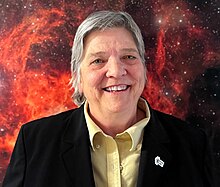
Lori Elaine Allen is an American astronomer, the director of Mid-Scale Observatories at NOIRLab, a center for ground-based optical and infrared astronomy funded by the National Science Foundation that operates several astronomy facilities worldwide.

Lori Elaine Allen is an American astronomer, the director of Mid-Scale Observatories at NOIRLab, a center for ground-based optical and infrared astronomy funded by the National Science Foundation that operates several astronomy facilities worldwide.
Allen has a bachelor's degree from the University of California, Santa Cruz, [1] and a Ph.D. from the University of Massachusetts Amherst. [2] Her 1996 doctoral dissertation, Star formation in Lynds 1641, was supervised by Karen Strom. [1] [3]
She worked on the Infrared Array Camera of the Spitzer Space Telescope, at the Harvard–Smithsonian Center for Astrophysics, before moving in 2009 to the National Optical Astronomy Observatory, the predecessor organization to the NOIRLab. She has been associate director of the Kitt Peak National Observatory, and acting director of the National Optical Astronomy Observatory. As director of Mid-Scale Observatories, her responsibilities include oversight of both the Kitt Peak National Observatory and the Cerro Tololo Inter-American Observatory. [2]
Allen was named to the 2023 class of fellows of the American Association for the Advancement of Science, "for exceptional leadership in advancing ground-based optical-infrared astronomy". [4]

The Kitt Peak National Observatory (KPNO) is a United States astronomical observatory located on Kitt Peak of the Quinlan Mountains in the Arizona-Sonoran Desert on the Tohono Oʼodham Nation, 88 kilometers (55 mi) west-southwest of Tucson, Arizona. With more than twenty optical and two radio telescopes, it is one of the largest gatherings of astronomical instruments in the Earth's northern hemisphere.

The Gemini Observatory comprises two 8.1-metre (26.6 ft) telescopes, Gemini North and Gemini South, situated in Hawaii and Chile, respectively. These twin telescopes offer extensive coverage of the northern and southern skies and rank among the most advanced optical/infrared telescopes available to astronomers. (See List of largest optical reflecting telescopes).
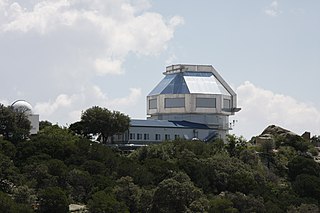
The WIYN Observatory is owned and operated by the WIYN Consortium. Its 3.5-meter telescope is the second largest optical telescope at Kitt Peak National Observatory in Arizona. Most of the capital costs for the observatory were provided by the University of Wisconsin–Madison, Indiana University, and Yale University, while the National Optical Astronomy Observatory (NOAO) provides most of the operating services. The NOAO is an institution of the United States; it is the national optical observatory program and supports a collection of ground-based telescopes at Kitt Peak as well as other locations.

The National Optical Astronomy Observatory (NOAO) was the United States national observatory for ground-based nighttime ultraviolet-optical-infrared (OUVIR) astronomy. The National Science Foundation (NSF) funded NOAO to provide forefront astronomical research facilities for US astronomers. Professional astronomers from any country in the world could apply to use the telescopes operated by NOAO under the NSF's "open skies" policy.

The Cerro Tololo Inter-American Observatory (CTIO) is an astronomical observatory located on the summit of Mt.Cerro Tololo in the Coquimbo Region of northern Chile, with additional facilities located on Mt. Cerro Pachón about 10 kilometres (6.2 mi) to the southeast. It is approximately 80 kilometres (50 mi) east of La Serena, where support facilities are located. The site was identified by a team of scientists from Chile and the United States in 1959, and it was selected in 1962. Construction began in 1963 and regular astronomical observations commenced in 1965. Construction of large buildings on Cerro Tololo ended with the completion of the Víctor Blanco Telescope in 1974, but smaller facilities have been built since then. Cerro Pachón is still under development, with two large telescopes inaugurated since 2000, and one in the final stages of construction as of 2023

The Association of Universities for Research in Astronomy (AURA) is a consortium of universities and other institutions that operates astronomical observatories and telescopes.

Aden B. Meinel was an American astronomer. He retired in 1993 as a distinguished scientist at the Jet Propulsion Laboratory. He also held the rank of professor emeritus at the University of Arizona College of Optical Sciences. His research interests have included upper atmospheric physics, glass technology, optical design, instrumentation and space systems.
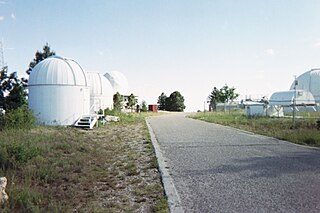
Mount Lemmon Observatory (MLO), also known as the Mount Lemmon Infrared Observatory, is an astronomical observatory located on Mount Lemmon in the Santa Catalina Mountains approximately 28 kilometers (17 mi) northeast of Tucson, Arizona (US). The site in the Coronado National Forest is used with special permission from the U.S. Forest Service by the University of Arizona's Steward Observatory, and contains a number of independently managed telescopes.
Catharine "Katy" D. Garmany is an astronomer with the National Optical Astronomy Observatory. She holds a B.S. (astrophysics), 1966 from Indiana University; and a M.A. (astrophysics), 1968, and Ph.D. (astronomy), 1971, from the University of Virginia. Catharine's main areas of research are massive stars, evolution and formation; astronomical education.
Harvey Raymond Butcher III is an astronomer who has made significant contributions in observational astronomy and instrumentation which have advanced understanding of the formation of stars and of the universe. He received a B.Sc. in Astrophysics from the California Institute of Technology in 1969, where he contributed to the development of advanced infrared spectrometry applied in the first survey of the sky at infrared wavelengths.

The Nicholas U. Mayall Telescope, also known as the Mayall 4-meter Telescope, is a four-meter reflector telescope located at the Kitt Peak National Observatory in Arizona and named after Nicholas U. Mayall. It saw first light on February 27, 1973, and was the second-largest telescope in the world at that time. Initial observers included David Crawford, Nicholas Mayall, and Arthur Hoag. It was dedicated on June 20, 1973 after Mayall's retirement as director. The mirror has an f/2.7 hyperboloidal shape. It is made from a two-foot thick fused quartz disk that is supported in an advanced-design mirror cell. The prime focus has a field of view six times larger than that of the Hale reflector. It is host to the Dark Energy Spectroscopic Instrument. The identical Víctor M. Blanco Telescope was later built at Cerro Tololo Inter-American Observatory, in Chile.
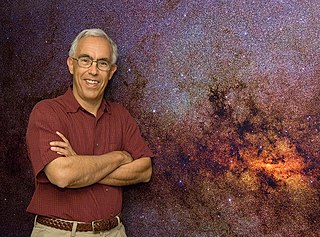
Dr. Thomas A. Prince is the Ira S. Bowen Professor of Physics at the California Institute of Technology and holds a joint appointment with Caltech’s NASA Jet Propulsion Laboratory (JPL) as a senior research scientist. Between May 2001 and June 2006, Prince was the chief scientist at JPL. He is currently the director and Allen V.C. Davis and Lenabelle Davis Leadership Chair for the W. M. Keck Institute for Space Studies at Caltech.

Belinda Jane Wilkes is a Senior Astrophysicist at the Smithsonian Astrophysical Observatory (SAO) in Cambridge, Massachusetts, US, and former director of the Chandra X-ray Center.
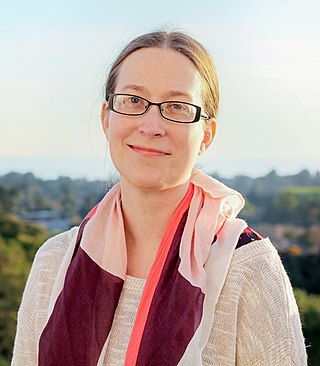
Beth Willman is an American astronomer who is the Chief Executive Officer of the LSST Discovery Alliance, an astronomical organization notable for its support of the Vera C. Rubin Observatory. She was previously the deputy director of the National Optical-Infrared Astronomy Research Laboratory (NOIRLab) and an associate professor of astronomy at Haverford College.

Richard Frederick Green is an American astronomer, former director of the Kitt Peak National Observatory, UKIRT and the Large Binocular Telescope Observatory.
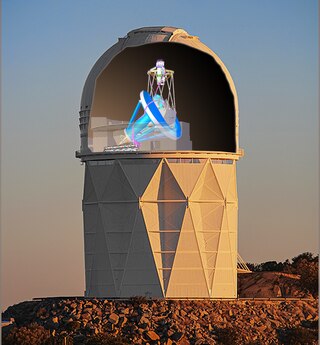
The Dark Energy Spectroscopic Instrument (DESI) is a scientific research instrument for conducting spectrographic astronomical surveys of distant galaxies. Its main components are a focal plane containing 5,000 fiber-positioning robots, and a bank of spectrographs which are fed by the fibers. The instrument enables an experiment to probe the expansion history of the universe and the mysterious physics of dark energy. The main DESI survey started in May 2021. DESI sits at an elevation of 6,880 feet (2,100 m), where it has been retrofitted onto the Mayall Telescope on top of Kitt Peak in the Sonoran Desert, which is located 55 miles (89 km) from Tucson, Arizona, US.
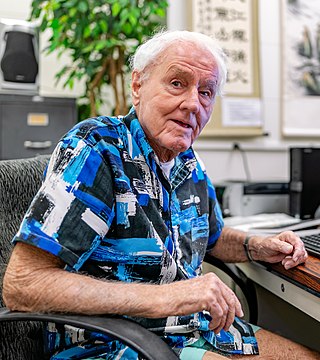
Helmut Arthur Abt is a German-born American astrophysicist, having worked at the National Optical Astronomy Observatory and an Elected Fellow of the American Association for the Advancement of Science. He is astronomer emeritus at Kitt Peak National Observatory.

Sidney Carne Wolff is an American astrophysicist, researcher, public educator, and author. She is the first woman in the United States to head a major observatory, and she provided significant contributions to the construction of six telescopes. Wolff served as Director of the Kitt Peak National Observatory (KPNO) and the National Optical Astronomy Observatory (NOAO). She is a member of the International Astronomical Union's Division G: Stars and Stellar Physics.

Dara J. Norman is an astronomer and the deputy director of the Community Science and Data Center at the National Science Foundation's National Optical-Infrared Astronomy Research Laboratory (NOIRLab) in Tucson, Arizona. She is also the Association of Universities for Research in Astronomy Diversity Advocate at NOAO. Her research centers on the influence of Active Galactic Nuclei (AGN) on the evolution of galaxies. In 2020, she was inducted into the inaugural cohort of American Astronomical Society Fellows in recognition of her leadership and achievements.
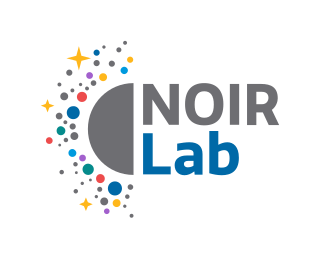
NSF’s NOIRLab is a United States federally funded research and development center for ground-based, nighttime optical and infrared astronomy.